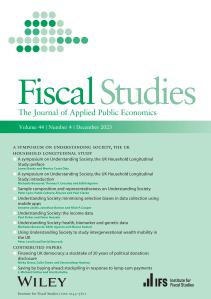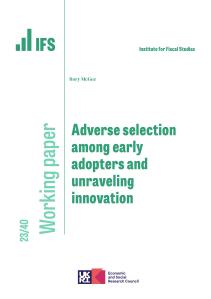The UK has witnessed a substantial and sustained increase in house prices since the 1990s. This long-term rise in house prices, and the financial crisis which led to falls in real incomes and reduced availability of high loan-to-value mortgages, are perhaps the main causes of widespread concern about the ‘affordability’ of housing. In a new election briefing note funded by the Nuffield Foundation and published today, IFS researchers set out a range of evidence on how the affordability of housing, and – related to that – the kinds of housing that people access, have been evolving.
The real price of purchasing a typical house, as measured by the Nationwide house price index, nearly trebled between 1995–96 and 2007–08, taking it 77% higher than its previous peak in 1989. When thinking about affordability, we of course want to account for changes in incomes too. At their peak in 2007–08, average house prices were 7.6 times average net household incomes – significantly higher than the ratio of 6.4 at the end of the previous house price boom in 1989. But real house prices then fell by nearly a quarter between 2007–08 and 2012–13. This left the price to net household income ratio at 6.2 – back to around its early 2000s level and close to its level at the end of the 1980s boom. Significant real growth in house prices resumed from 2013–14.
When considered in combination with the lesser availability of mortgage credit since the crisis, it is not surprising that there is concern over the ease of access to homeownership. And in London, house price to income ratios have bounced back substantially more quickly since the financial crisis. Indeed, if we use pre-tax average earnings (for which, unlike net household income, we have data beyond 2012–13), we see that in 2013–14 the price to earnings ratio in London had already surpassed its pre-crisis peak.
House prices are just one part of the story though. When thinking about the cost or affordability of housing, we should distinguish carefully between the costs of coming to own a property (which depend largely on house prices relative to families’ resources) and the ongoing regular costs associated with the consumption of housing – most importantly, mortgage interest for owner-occupiers and rents for renters. Although there are economic reasons why these costs are all related, it is possible for them to move in very different ways in the short run. Indeed, trends in these different costs have diverged emphatically since the recession.
Between 2007–08 and 2012–13, owner-occupiers with a mortgage saw a 38% real-terms fall in their real housing costs, due to large falls in interest rates. (Note that these housing costs include mortgage interest but not capital repayments, which are loan repayments and hence increase net wealth.) Their real incomes fell over this period too, but as a proportion of income their housing costs still fell from 16% to 10%. In that sense, for this particular group, the ‘affordability’ of housing has clearly been very forgiving of late. This is likely to be a key reason why the number of repossessions in the recent recession was so much lower than in the previous one. Although it has been getting harder to buy a house for the first time, it has been relatively easy for those already owning one to hold onto it.
Meanwhile, costs for renters have not been offering anything like this scale of relief. Housing costs as a proportion of income rose for renters between 2007–08 and 2012–13, from 25% to 27%. Even here, though, the story is perhaps a little more benign than popularly perceived. Average housing costs for private sector tenants have actually risen little faster than other (non-housing) prices since 2007–08.
Perhaps the biggest issue here is a distributional one – different groups have been affected very differently by housing trends. Changes in the regular costs of housing consumption have been very favourable for the group of people who already own a home relative to the group who don’t. Meanwhile, high house prices and tighter credit conditions make it harder to move from the latter group into the former. And of course all this follows large (and tax-free) capital gains over an extended period for a group of owner-occupiers who bought at much lower prices than it would be possible to find today.
Much of this is of particular relevance when thinking about the distribution of resources between generations. There has been a striking decline in homeownership that largely reflects differences across successive generations. The homeownership rate at age 35 of those born in the mid-1970s was 10 percentage points lower than it was for those born in the mid-1960s at the same age; the age-25 homeownership rate has halved in 20 years. There is also evidence of divergence in housing characteristics between generations. Couples aged 60 and over saw an 11% increase in floor space per person between 1996 and 2012, and single people aged 60 and over saw an 8% increase. Meanwhile, for most working-age household types, floor space per person was flat or falling.
But there are potentially important issues here for inequality within generations as well. Young homeowners have actually done particularly well out of low interest rates – because they have the most outstanding mortgage debt, interest rates make the most difference to them – while a growing number of young adults remain as renters. And much of the housing wealth currently held by older generations could eventually come to be owned by some portion of the younger generation via inheritances passed on at death or through financial assistance from parents to children.
In summary, then, there are actually some respects in which recent trends in the affordability of housing look rather less troubling than some of the debate might suggest; but the picture varies greatly between owners and renters, with implications for the distribution of resources within and between generations.
What are the policy challenges? We argue in the briefing note that there is reason to think that historically high house prices relative to incomes partly reflect a mismatch between supply and demand, and policies that look to address this are likely to be important. There is also a strong case for reform to the taxation of housing (as discussed in the Mirrlees Review). As it happens, one of the most efficiency-enhancing tax reforms that could be made would also help credit-constrained first-time buyers: namely, abolishing stamp duty land tax – an extremely damaging tax which discourages mutually beneficial housing transactions. If the government wanted to replace the revenue, a sensible way of doing so would be through a revalued and reformed council tax. Finally, there are challenges for the public finances. A future government will need to take a view on whether it would be prepared to earmark increasing amounts of its budget to housing benefit if rents continue to rise over the long term and/or the growth of the private rented sector continues.










